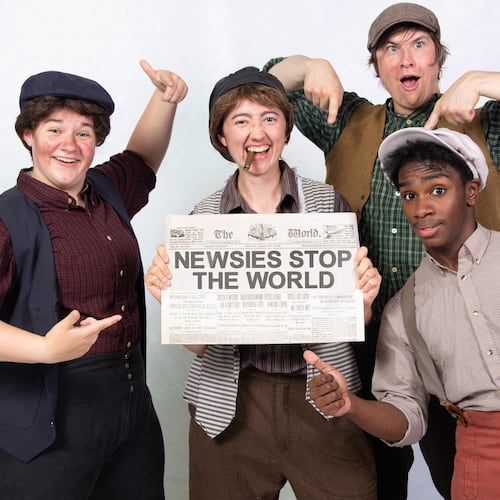If there is a bounce in everyone's step at Atlanta Ballet's new headquarters, it's not just because of a hip-shaking rehearsal for "Moulin Rouge --The Ballet," which opens the company's 81st season Friday.
While there's plenty of joie de vivre on display as male dancers tip top hats, their female partners swoosh long skirts, and still others kick back at cafe tables sipping imaginary French wine, it's not just the can-can shakin' that has everyone smiling this recent afternoon.
Part of the sunny vibe comes from the fact all this business is taking place in the company's handsome new $10.9 million headquarters, a modernization of a 1955 appliance factory on Marietta Boulevard, on the edge of Atlanta's burgeoning Midtown West district.
Another reason for optimism is the man in the corner office, new executive director Arthur Jacobus, who helped guide the San Francisco Ballet to national prominence until 2002 and more recently directed the Pilchuck Glass School near Seattle.
The new pad -- which, no small matter, is already paid for -- and the highly regarded new leader have everyone inside the airy 54,000-square-foot Michael C. Carlos Dance Centre talking about the dawning of a new day for Atlanta Ballet. That's saying something for a company that is the longest continuously operating dance troupe in the United States and just last season celebrated its 80th anniversary and 50 years of performing the ever-profitable "Nutcracker."
But at a time when many cultural groups are scaling back Atlanta Ballet is pushing forward. It's guided by a three-year strategic plan promptly drawn up by consensus-builder Jacobus that seeks to stabilize the company's roller-coaster finances while repositioning a troupe known for classic story ballets as one that's highly physical and capable of conquering more edgy contemporary premieres.
"It feels like a fresh start," said Christine Winkler, a company member starting her 16th season. "There's so much energy about the new place and about Arthur. You feel that this is such a beautiful building to come to work in every day. You feel proud to be part of the Atlanta Ballet."
The new vibe is reflected even in the super sexy black-and-white blown-up photos adorning the central hallway that connects the five full-size dance studios, including a Vogue-worthy one of Winkler in a tiny tutu on a loading dock, drenched in a downpour. The pics are from a series shot by longtime company photographer Charlie McCullers at the new headquarters during demolition-construction, and have been compiled into a calendar benefiting the ballet's Dancer's Resource Fund.
While not quite as overtly hot, noted magazine photographer Jim Fiscus' sensual photos for the season brochure and advertising are a striking departure from the darker, gold-toned, storybook images of seasons past. It's as if Atlanta Ballet is a Sleeping Beauty who's awakened from her slumber and is suddenly feeling a little frisky.
Sure enough, the image for February's production of "Sleeping Beauty" does not depict the expected chaste kiss by the handsome prince leaning over his drowsy princess, but instead pictures Aurora placing her hand on her man's six-pack, like she's got her own ideas about where to take the story.
"The direction that Arthur challenged us to go for was to make everything we do bright, vibrant and more about the emotions of ballet and less about the story," marketing director Tricia Ekholm said. "I don't know if sexy is the right word, but we really want to make people aware that physically the dancers are like athletes. Their bodies are their art, and they have gorgeous, beautiful bodies that work really hard."
Artistic director John McFall has no qualms about the representation. He considers his 21 company members and six apprentices "thoroughbreds," and is excited about a $500,000 fund that Jacobus created to allow him to seek new choreography here and abroad to challenge them.
"It's a huge opportunity for our dancers," said McFall, who programmed four world premieres and three company premieres this season and will head to a dance summit in Tel Aviv in January to scope out Israeli choreographers on the rise. "They're vitally interested in working with some of the best choreographers from around the globe, being ... instrumental in creating new work."
Jacobus' arrival means McFall -- who since 1994 has worked with five executive directors and two interim directors and soldiered through other periods when board members stepped in to help him hold down the fort -- is now free to focus on matters artistic.
"John's now in the studio more and working with us more," noted Winkler, who with husband John Welker were the first dancers McFall hired. "It' s great -- how it should be."
McFall said he considers Jacobus a true partner who "supports the artistic vision with enthusiasm." As he's reached out to colleagues at other regional companies to propose arrangements that would split expenses of staging new full-evening works, McFall said, all of them express excitement about Jacobus. "I hardly go through a conversation with another artistic director who doesn't tell me, ‘You're one lucky fellow,'" McFall recounted.
A quiet-spoken man with a dignified manner, Jacobus admits he wasn't much aware of the Atlanta company's work when he took the job. "I didn't have any expectation that it was less than exceptional in terms of technical ability," Jacobus said. "But I wasn't very familiar with the style of the company."
In short order, though, he was wowed by the performance quality and dancers' versatility during last season's closing production of "Vivaldi's Four Seasons," he said, and found himself "very, very encouraged" about the future.
Jacobus is certain of his mission: to guide the company to financial stability and sustainability. In June, he increased the ballet's $14.8 million capital campaign goal by $4.5 million. The company has raised $14.8 million in 22 months. He wants to raise the "small" endowment, now valued at $3 million, to close to $6 million.
The ballet owns outright the new headquarters -- also home to its growing school, the Centre for Dance Education -- which allows him to start from an enviable place. That's courtesy of the fact the company sold its old West Peachtree Street headquarters in Midtown for $12 million in 2007, when the real estate market was stronger. In the red to the tune of $2.75 million then, the ballet is debt-free today.
But Jacobus nonetheless proceeds with caution.
"Because of the sale of the property, because of the success of the capital campaign, our financial statements look very good," he said. "But none of us feel that this is sustainable. We've got to find a way to have reasonably reliable ticket sales, reasonably reliable annual fund-raising and have those reasonably match expenses every year. It's always going to be a big challenge."
One of the bigger challenges, of course, is operating as one of the larger cultural institutions in the shadow of the Woodruff Arts Center, which attracts a large share of Atlanta's corporate arts giving.
"It doesn't leave a lot for the ballet and other organizations," said Jacobus, who believes the dance company's corporate support "needs a lot of work." He considers foundation giving, a lot of which has been switched to social services in recent years, equally "uneven."
In the meantime, he brought in the marketing research firm TRG Arts to better understand the ballet's audience, which will influence programming and how marketing "aggressively" targets it. The new season seems to strike a balance between the familiar ("Sleeping Beauty," "Nutcracker") and the new (especially a May mixed-rep program, which instead of being at Cobb Energy Performing Arts Center will be staged intown at the more intimate Alliance Theatre).
"You're going to see more edgy stuff, more physical stuff," Jacobus said. "And can the community support that sort of thing? I believe they can."
About the Author
Keep Reading
The Latest
Featured

